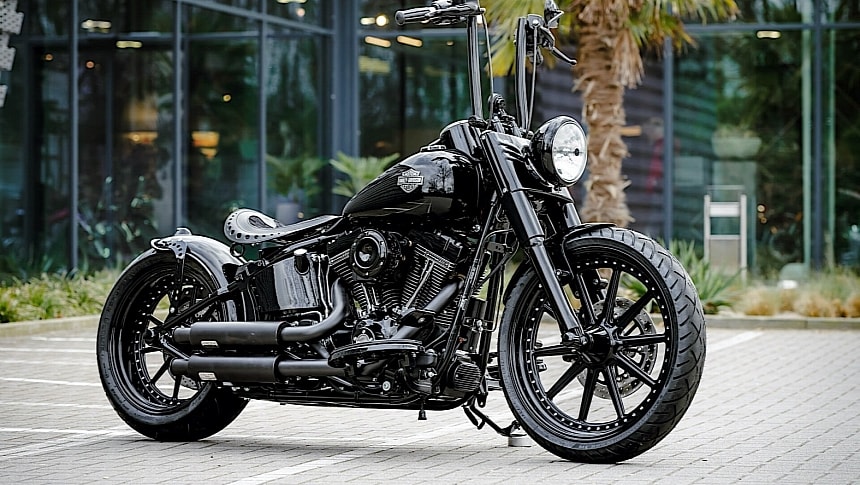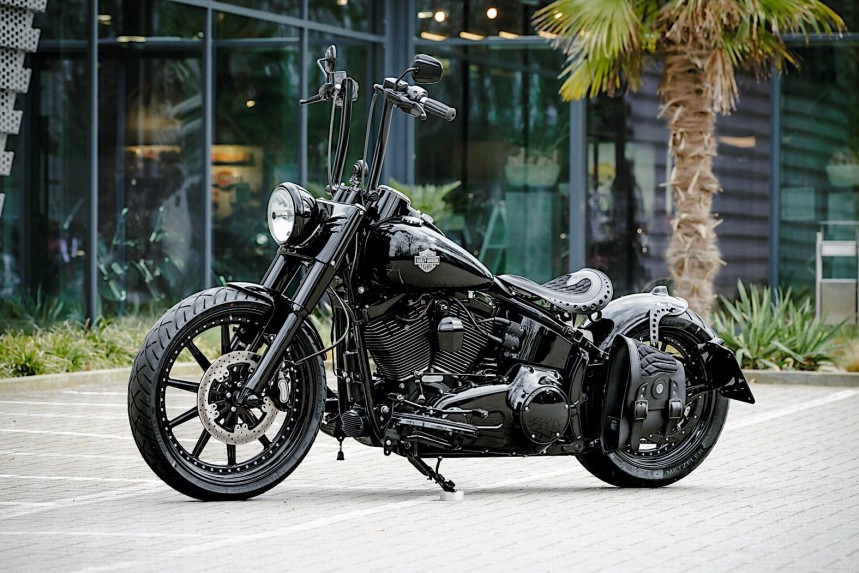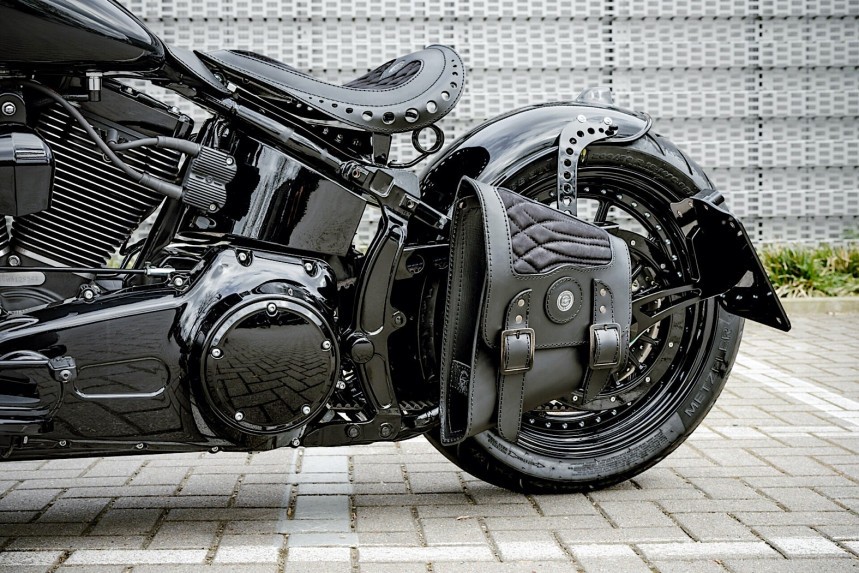It's hard to believe it's been four decades already since Harley-Davidson introduced the Softail platform for two-wheelers. Four decades of several extraordinary motorcycles coming to light, almost all of them incomplete enough, on some level, to give the countless specialized shops around the world room for improvement, so something to do.
It is this June that Harley is celebrating the 40th anniversary of the Softail. So far, the Milwaukee brand has steered clear of actually releasing a model dedicated to the occasion, but there's a lot of time left for that to happen still (we hope). Until then, we can always have a look at what Softails usually become in the hands of custom garages that have made a name for themselves over the years.
The Softail breed was born in 1984 with the FXST Softail. It was an evolution of a motorcycle concept Harley got from an independent engineer named Bill Davis, and made waves by combining the classic look of a hard tail motorcycle with the comfort provided by a full rear suspension system.
The design has largely remained the same since its introduction, and it is presently applied on no less than seven Harley-Davidson models: Softail Standard, Street Bob, Low Rider, Breakout, Heritage Classic, Fat Boy, and Fat Bob.
Like all other Harley motorcycles, the above existing models often get customized into more or less extreme shapes, but the same applies to the Softail models Milwaukee is no longer making. Like, say, the Softail Slim S.
This moniker has been around for most of the past decade (the 2010s), and even if it's no longer being made, it can still be found roaming the streets of the world, constantly ending up on the workbench to be modified to some extent.
That's probably what happened to the Softail Slim S we have here, now called the Dark Hopper on account of its color scheme, and God knows what else.
The bike was born on the Harley factory floor in 2016, meaning it is one of the last models to be equipped with the Twin Cam engine. On the market from 1998 to 2017, when it was replaced by the current Milwaukee-Eight, this powerplant was offered with displacements ranging from 88ci to 110ci when talking about the more potent CVO models.
The Slim sitting before us packs the largest version of the engine available, also rocking Screamin' Eagle components. It wasn't modified much for the purposes of turning it into the Dark Hopper, but it did get a Dr. Jekill & Mr. Hyde exhaust that has an undisclosed effect on its performance levels.
The idea behind the customization of this Slim S was to take its "disproportionate, if not chubby" appearance out of the equation and replace it with something truly slim. That meant, first and foremost, parting ways with the stock, 16-inch wheels.
They were replaced with in-house-made ones. They come in a ten-spoke design and much larger than the original versions: 21 inches at the front (wrapped in a 130 mm tire) and 18 inches at the rear (wearing rubber that is 200 mm wide).
Despite the fitting of a much larger wheel at the front, the fork geometry remains largely the same as before. There is, however, a fork lowering kit in place to help get the bike's nose to the same level as the rear, it too boasting a lowered shock absorber.
The rear end was cleared up by replacing the stock fender and struts with a fender of the swinging variety with included tail lights, held in place by perforated struts (at the opposite end, the fender is barely noticeable). Even the brake disc was moved further back, between the wheel and the pulley, in a bid to clear up the look of the rear end some more.
Thunderbike also replaced the original seat of the Softail Slim S, installed a new air filter, and fitted new dark signals of the Kellermann variety. When all was said and done, the color black was chosen to dress up the project, because there's nothing better to make things look slimmer in the right light.
The changes made to the stock motorcycle are far less extensive than what we're used to seeing from Thunderbike, but that's only because "some parts of the customer's bike had already been modified" before getting this latest makeover.
What that also means is that the Harley-Davidson Dark Hopper is significantly less expensive than many of the other Thunderbike projects we've seen in recent times. Not including the base motorcycle, which can be had on the used motorcycle market for anywhere between $11,000 and $15,000, the total cost of the parts used in the build amounts to 6,500 euros, which is close to $7,000 at today's exchange rates.
As usual, that doesn't cover the man hours spent putting the bike together, the paint job, and the aftermarket exhaust system.
The Softail breed was born in 1984 with the FXST Softail. It was an evolution of a motorcycle concept Harley got from an independent engineer named Bill Davis, and made waves by combining the classic look of a hard tail motorcycle with the comfort provided by a full rear suspension system.
The design has largely remained the same since its introduction, and it is presently applied on no less than seven Harley-Davidson models: Softail Standard, Street Bob, Low Rider, Breakout, Heritage Classic, Fat Boy, and Fat Bob.
Like all other Harley motorcycles, the above existing models often get customized into more or less extreme shapes, but the same applies to the Softail models Milwaukee is no longer making. Like, say, the Softail Slim S.
This moniker has been around for most of the past decade (the 2010s), and even if it's no longer being made, it can still be found roaming the streets of the world, constantly ending up on the workbench to be modified to some extent.
The bike was born on the Harley factory floor in 2016, meaning it is one of the last models to be equipped with the Twin Cam engine. On the market from 1998 to 2017, when it was replaced by the current Milwaukee-Eight, this powerplant was offered with displacements ranging from 88ci to 110ci when talking about the more potent CVO models.
The Slim sitting before us packs the largest version of the engine available, also rocking Screamin' Eagle components. It wasn't modified much for the purposes of turning it into the Dark Hopper, but it did get a Dr. Jekill & Mr. Hyde exhaust that has an undisclosed effect on its performance levels.
The idea behind the customization of this Slim S was to take its "disproportionate, if not chubby" appearance out of the equation and replace it with something truly slim. That meant, first and foremost, parting ways with the stock, 16-inch wheels.
They were replaced with in-house-made ones. They come in a ten-spoke design and much larger than the original versions: 21 inches at the front (wrapped in a 130 mm tire) and 18 inches at the rear (wearing rubber that is 200 mm wide).
Despite the fitting of a much larger wheel at the front, the fork geometry remains largely the same as before. There is, however, a fork lowering kit in place to help get the bike's nose to the same level as the rear, it too boasting a lowered shock absorber.
Thunderbike also replaced the original seat of the Softail Slim S, installed a new air filter, and fitted new dark signals of the Kellermann variety. When all was said and done, the color black was chosen to dress up the project, because there's nothing better to make things look slimmer in the right light.
The changes made to the stock motorcycle are far less extensive than what we're used to seeing from Thunderbike, but that's only because "some parts of the customer's bike had already been modified" before getting this latest makeover.
What that also means is that the Harley-Davidson Dark Hopper is significantly less expensive than many of the other Thunderbike projects we've seen in recent times. Not including the base motorcycle, which can be had on the used motorcycle market for anywhere between $11,000 and $15,000, the total cost of the parts used in the build amounts to 6,500 euros, which is close to $7,000 at today's exchange rates.
As usual, that doesn't cover the man hours spent putting the bike together, the paint job, and the aftermarket exhaust system.















